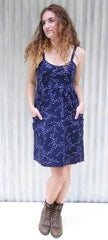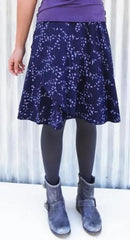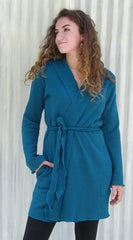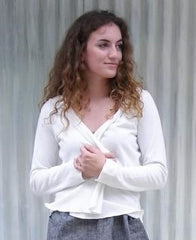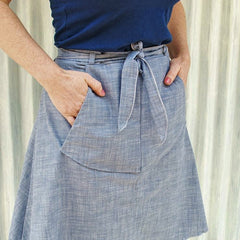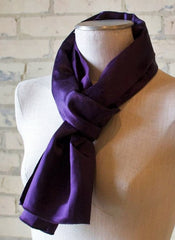FYI, I’m not a doctor; follow my guidance at your own risk!
I’ve been asked by enough people now "does this have bamboo in it” or "can this be made without spandex.” I’m finally writing the ultimate shopping guide for finding the most natural clothing from Yana Dee. Not only is this best for your skin, is also good for the planet!
What you put on your skin can change how it looks and feels. Since you probably put more clothes on your skin than any other product, picking out the right clothes to wear is key to keeping skin healthy- or bringing it back when an issue arises. Tough love isn’t a good strategy on eczema, acne, or rashes. Practice soft love with all-natural, non-irritating clothes instead.
First of all, what bra are you wearing?
Finding a good bra is not easy. While it does contain some Lycra, our “least irritating” bra is our Bailey Bra. It is made from mostly Organic Cotton and Hemp. It has good support and it doesn’t have any hooks, wires, or fasteners that might irritate. This is the only spandex-containing product recommendation I will make in this blog. Everything else will be 100% natural, as well as free of bamboo, soy, and wool.
100% Organic Cotton Options
100% Organic Cotton Crepe fabric makes a great summer top on it’s own, or wear it as an undershirt all year round. The cap sleeve version will even protect your shoulders from the sun. The sleeveless top can be worn under a uniform or other potentially irritating work-clothes, to protect the skin at your core. Even if you don’t go sleeveless in public, these tops will still be a great base or home piece. We can also custom make a beautiful, 100% Organic Cotton Crepe pocket dress for you!
100% Organic Cotton Bird Print comes in 3 colors, and can be made into wrap skirts and dresses.
Add Hemp
If you are able to wear Hemp, your options really start to widen at Yana Dee. Our hemp options are blended with Organic Cotton. It is certainly possible to be allergic to Hemp, and some people find hemp "scratchy”. If you are battling an undiagnosed skin allergy and your skin gets lightly scratched, this might trigger a reaction. It is possible that after eliminating the true culprit of your unhappy skin, your actually like hemp. If you want to try some Hemp & Organic Cotton fabrics, here are your options:
Hemp & Organic Cotton Fleece is your cold-weather friend. Most fleeces on the market are made from polyester; this one is all natural. If you have tried hemp before and thought it was scratchy, this hemp is different! It is just soft and cozy. It is the most gentle version of Hemp available. And, it is warm! It is great for outer layers, winter dresses, and sweaters.
Hemp & Organic Cotton Jersey is much lighter weight than fleece, and has a soft drape. Hemp & Organic Cotton Jersey is a good temperature-regulating fabric. Wear it on it’s own in the summer, or layered in the winter. It can be used for wrap skirts, tops, dresses, and outer layers. If you going strictly natural, make sure you read the fine print and avoid the Hemp & Organic Cotton Lycra Jersey; that fabric is not 100% natural.
Hemp & Organic Cotton Straight Weave Fabrics. We use chambray, denim, and ticking to make mini, mid, and maxi wrap skirts. These fabrics are also used for pocket dresses. All of these items share a classic, even vintage-like feel.
Linen is Winning.
We have a few items that are 100% Linen. Linen is often found pure; that means it shouldn’t be too hard to identify if you are allergic or sensitive to it. If linen is on your cleared list, we have some dresses and tops for you to wear!
Silk makes you Fancy.
Hemp silk charmeuse is an all-natural fabric we use for fancy wrap skirts and dressy scarves. Just beautiful!
Start Shopping or Keep Reading
If you are ready to start shopping, click here to startt browsing. If you want more guidance to help you discover what fibers are on your personal safe-list, keep reading.
How to figure out what to avoid
- Try first: 90% Natural. Your skin is your largest organ, and it needs to breathe. Fabrics made from polyester, acyrlic, and nylon are essentially plastic. They have too much moisture seal and don’t let your skin breathe like it is supposed to. So, if you want your skin to be the happiest it can be, you will probably have to avoid synthetic fibers; but you might not have to eliminate them. A plastic shell can be great in the rain and wind, but it’s a good policy to keep anything containing more than 10% unnatural fibers separated from your skin, by wearing an all-natural layer underneath. As long as you aren’t allergic to anything in your clothes, you should be able to wear a little bit of unnatural fibers, and stay healthy. Natural fibers to seek out on clothing tags are hemp, cotton, silk, linen, and wool.
- Next up: get rid of rayon and other highly-processed natural fibers. All-natural wood pulp is the initial ingredient of most rayon. The process of turning a tree into an outfit can’t currently be done without a lot of chemicals. So while cutting down a Beach tree is the first step to making Modal, you might want to avoid certain “natural” fibers, if your skin (or ethics) want to avoid complicated chemistry. Processing side-affects aren’t the only downside of over-engineered rayon; it also isn’t exceptionally breathable or durable. Acetate, Modal, and Viscose are some of the six “types” of Rayon. Although Bamboo and Soy are natural, they do take more processing than other natural fibers. They are also an allergen to certain people. If 90% natural isn’t good enough for your skin, try going without Bamboo, Soy, and all forms of Rayon.
- Go strict & pure. If you did step 1 and 2 above, and still your skin isn’t satisfied, only allow all-natural fabrics to touch your skin. Don't be tempted to keep wearing your favorite yoga pants (that are 18% spandex) or your cute recycled polar fleece (that is 100% polyester). If you think you might be allergic to something along the lines of Toluene-2,4-diisocyanate; Methylene bisphenyl-4,4-diiisocyanate, cut out everything except hemp, cotton, silk, linen, and wool (also eliminate any of these you have a suspected allergy or intolerance to.) If you avoid blends of more than 2 of these fibers, it makes it much easier to discover any true allergies or intolerance you have. Getting a medical allergy test could also be helpful if you want to diagnose your reactions with certainty. When researching for this blog, I was not surprised to learn that many more people think they are allergic to wool than actually are. And not all wool is created equally; while a chunky Shetland sweater might make you want to pick and scratch, a pure merino cardigan might be fine.
TL;DR. If you are having skin issues, try something from Yana Dee.
What do you think? I would love read comments about clothing fiber and skin health. What has worked for you? Please share your strategy with others!





